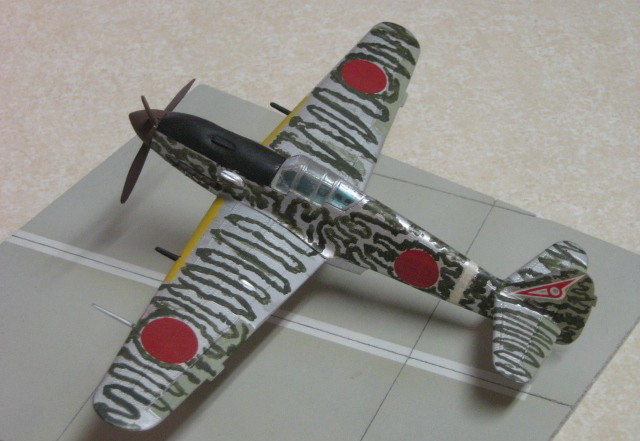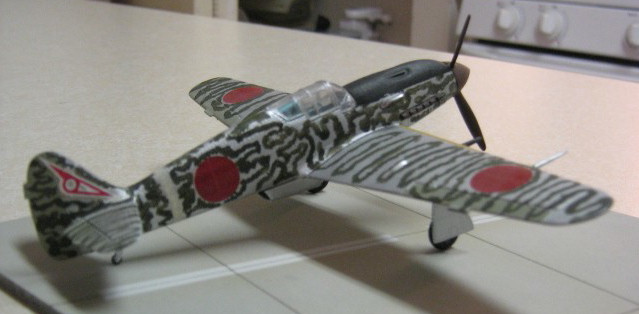
| KIT #: | H-686 |
| PRICE: | $1 at a swap meet |
| DECALS: | One option |
| REVIEWER: | Rick Crabill |
| NOTES: | Part of a '3 in 1' kit with a P-51 and Ki-84. |

| HISTORY |
The Kawasaki Ki.61 Hein was the only frontline fighter in the IJAAF to be powered with an inline engine, a license copy of the German DB.601. Assigned the code name "Tony" because of its supposed resemblance to the Italian Macchi C.202, the Ki.61 was a welcome addition to Japanese squadrons when it first came into use in 1942. It was a nasty surprise for Allied pilots who were unable to use the standard evasive tactic of diving away. It was found that "Tony" could dive as well as most heavier Allied planes. To avoid any charges of plagiarism, let me just say that more info can be found on this excellent plane on the web.
| THE KIT |
This kit has been released several times since the 1960’s. The one here is from “Fighters of the Pacific”, catalog # H-686. This 3-pack included the P-51D Mustang and Nakajima Ki.84 “Frank” as well as the “Tony”. All these models share the same inaccuracies of line, heavy raised rivets and panel lines, and lack of interior detail common to kits of this vintage. However, they are simple to build and relatively inexpensive.
| CONSTRUCTION |
 Being an old mold, cleanup was mainly on the
fuselage halves. Mold gates were sanded down to prevent gaps between the halves.
After the halves were glued together, most of the seam work was on the upper
cowling. I attempted during this stage to get more of a curve on the cowling -
this is the major error in the shape of the kit. I wasn't too successful as I
did not want to sand away the troughs for the nose guns.
Being an old mold, cleanup was mainly on the
fuselage halves. Mold gates were sanded down to prevent gaps between the halves.
After the halves were glued together, most of the seam work was on the upper
cowling. I attempted during this stage to get more of a curve on the cowling -
this is the major error in the shape of the kit. I wasn't too successful as I
did not want to sand away the troughs for the nose guns.
When the subassemblies were glued together, there was no major gap between the wing and fuselage on the bottom. There is however a small gap on both sides between the wing trailing edges and the fuselage fillet. It is somewhat noticeable in the plan view of the model. I did not attempt to fill these gaps since my work with putty generally does more harm than good. The front to the radiator scoop did need to be sanded flush after it was glued on. (A nice feature is the exhaust gate being a separate molding, allowing one to position it open or closed).
The main landing gear is actually very sturdy. I did boo-boo on the tail wheel, forgetting to put it in place until after gluing the fuselage halves together. The remainder of assembly was straightforward. I generally build OOB, especially when doing "classic plastic" like this.
| COLORS & MARKINGS |
Kit decals depict a Kawasaki Ki.61-I kai of the 19th Sentai, 2nd Chutai (19th Fighter Gr., 2nd Sq.) on Home Defense duties, 1944-45.
Factory paint scheme for the Tony was bare metal, with fabric surfaces covered
in pale green fabric. The antiglare panel was black. The propeller and spinner
were a reddish-brown and the leading edge stripes were yellow. Group marking on
the tail was Red for the 2nd Squadron. Only the fuselage Hinomaru
were outlined in white. In the field, Dark
 Green mottling was added to this
standard finish for camouflage. Painted unevenly by hand, this scheme varied
widely between aircraft. I particularly like how the zigzag effect is very wide,
then narrows around the hinomaru and unit markings. The kit decals had not
yellowed to any real extent and fit fine
Green mottling was added to this
standard finish for camouflage. Painted unevenly by hand, this scheme varied
widely between aircraft. I particularly like how the zigzag effect is very wide,
then narrows around the hinomaru and unit markings. The kit decals had not
yellowed to any real extent and fit fine
The model was sprayed overall with Testor’s Aluminum Plate. Mottle is FS 34079 Dark Green. All other paints are AeroMaster acrylics:
Prop: 1099 A/N Red Brown Primer
Leading edge: 1086 A/N Yellow
Interior: 1084 Japan Aotake
Fabric: 1098 IJN. Sur. Army Gray/Gr.
| CONCLUSIONS |
A fun build. I thought this paint scheme might be tough, so I wanted to try it on a "cheap kit". The results were better than I expected. I also think this is my best effort at masking the Yellow leading edge areas common to Japanese aircraft post-1942. The poor shape of the nose and canopy means this kit will never be a contest contender, but the kit is striking in that hand-painted scheme. The basic nature of the model makes it suitable for beginning or average modelers.
| REFERENCES |
Japanese Army Fighters, Vol. 1 , William Green & Gordon Swanborough
Koku-Fan Illustrated No.42, Japanese Imperial Army&Navy Color and Marking
June 2006
If you would like your product reviewed fairly and fairly quickly, please contact the editore or see other details in the Note to Contributors.